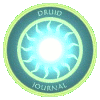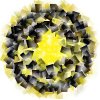Click here for the previous post in this series: The Function of Fiction.
Patterns of Plot, Patterns of Life
All that is gold does not glitter, Not all those who wander are lost. The old that is strong does not wither; Deep roots are not reached by the frost. From the ashes a fire shall be woken, A light from the shadows shall spring; Renewed shall be blade that was broken, The crownless again shall be king. –Tolkien

One way in which fiction influences our subconscious thinking is in its very structure, its plot. Different authors and different works have different plot styles and devices, sometimes woven carefully and consciously (The Quincunx), other times written on the fly with almost no forethought (Louis L’Amour). These patterns of plot can influence the way we, as readers, try to organize our own experiences — the way we make sense of our own stories. We come to expect our lives to unfold in the same way that our favorite fiction does.
For example, most people are familiar with Star Wars, which has a very formulaic and predictable plot structure — both for each movie, and for the story arcs of the movies overall:
- Each movie has three main acts or plot lines, each of which takes place at a different setting (e.g. Naboo, Tatooine, and Coruscant for The Phantom Menace, and Tatooine, Dagobah, and Cloud City for The Empire Strikes Back, etc.).
- The overall storyline echoes the mythic structure outlined by Joseph Campbell, from the miraculous birth of Anakin Skywalker to Luke’s confrontation with his father.
- Setting the standard for action films, the plot alternates between chasing, fighting, comic bantering, fighting while chasing, chasing while bantering, etc., with the (very) occasional quiet, serious scene. (Don’t get me wrong — I love these movies!)
- Frequently, one good guy is sent on a solitary mission, while the others go in a group, and the fate of one determines the fate of the other.
- Almost always, the plot crescendos towards some kind of infiltration — an attempt by the heroes to get into some fortified area and (usually) blow something up.
- And of course, someone’s hand gets chopped off in the meantime.
I don’t know how intentional these plot similarities are, but they lend the series coherence. They also, I’d argue, influence the viewer’s expectations about patterns of events in real life. I’m not saying that if you watch too much Star Wars, you’re going to start wearing titanium wrist guards. But you may find yourself thinking of your life more frequently in terms of episodic conflicts, semi-mythic conflicts between family members, and mighty struggles of good vs. evil.
Tolkien’s Trope
Tolkien does the same thing in The Lord of the Rings. Again and again, Tolkien uses a simple plot structure which moves his story along. You can see it from when Frodo first sets out, repeated with variations all the way to Mount Doom; and in fact it is reflected in the larger structure of the whole novel. The structure is this:
- Set out from a place of safety
- Go on a bumbling journey, during which danger increases
- Terrible peril, at which all is nearly lost
- Saved at the last minute by forces largely beyond the control of the characters
- Return to safety
- Overall, a sense that seemingly random or chance events are guided by external forces
Probably the most obvious place to see this structure is while the four hobbits are traveling from Bag End to Rivendell.
- They set out from Bag End, bumble their way through the woods, are almost found out by Black Riders, and are saved by elves.
- Then they go through the woods again, are almost attacked by Farmer Maggot’s dogs, and then are saved by the farmer himself.
- Then they are followed by Riders to the Ferry, only to be saved by Merry.
- Then they bumble their way through the Old Forest, are almost destroyed by the Willow, and are saved by Tom Bombadil.
- Then they bumble their way over the Barrow-Downs, are almost killed by a wight, and are saved by Bombadil again…
- And even with Strider leading them, they bumble across the Trollshaws until they’re almost at Rivendell, and are saved at the last minute by Elrond’s flooding river.
This is quite different than the usual fairy-tale structure, where the hero sets out, lays waste to a series of challenges, and then takes home the prize. Partly, of course, this is due to the fact that Tolkien’s main heroes are hobbits, and they’re not the swashbuckling hero types, but you can see it to a lesser extent with the other heroes too. For example, the entire Moria sequence can be seen as a bumbling journey, in which the company is saved only barely by the sacrifice of Gandalf, closely followed by the safety of Lorien.
Probably the most remarkable and unique thing about Tolkien’s structure is that while the heroes display fortitude, strength of will, and determination, they almost never defeat their enemies without a huge amount of outside help at the last minute. This actually reflects Tolkien’s Christian worldview — especially his concept of eucatastrophe.
The Eucatastrophe
The Wikipedia article does a great job explaining the concept; but briefly, eucatastrophe (pronounced you-catastrophe) is similar to a deus ex machina, except that in eucatastrophe, the sudden unexpected change in fortune is consistent with the established framework of the story.
For Tolkien, the arrival of Jesus was a eucatastrophe for human history, and his resurrection was a eucatastrophe in the story of the incarnation itself. In Tolkien’s view, humans are, after all, fallen; and for God to forgive us for our sins, to offer redemption in the form of Christ, is a sudden reversal of fortune indeed — but one which is not wholly unexpected or outside the framework of the sweep of human history. Tolkien wove this narrative structure (intentionally, I am sure) into every level of plot in The Lord of the Rings, making it a deeply Christian work. Compare this, for example, to the Norse cycle, in which no last-minute savior is offered to forestall Ragnarok; or to the Greek myths, in which deep character flaws or dire prophecies pretty much always lead to disaster (except, of course, in the case of deus ex machina). (I can’t think of a good example of eucatastrophe in pagan literature, but I’d be very interested to hear of any.)
Tolkien’s story structure, then, arises from his own belief system, permeates his work, and almost certainly influences the beliefs of those who love and read his works. Read enough Tolkien, I’d say, and you start to look for eucatastrophies in the patterns of your own life. Certainly I can testify to any number of last-minute scrapes in my own life that could easily be described as eucatastrophic.

And now it is just a short step to use Tolkien’s story structure for a Tarot spread, which I’ll describe and motivate in the next (and final) post of this series.





Leave a comment